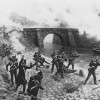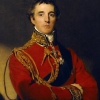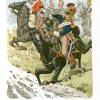 This timeline and its connected geospatial map are designed to support a COVE critical and teaching edition of Elizabeth Barrett Browning's "On a Portrait of Wordsworth, by R. B. Haydon." By using these new tools, we unpack the full cultural and historical complexity of this 14-line poem, an ekphrasis of Haydon's portrait. You can link to the other two documents of this edition here:
This timeline and its connected geospatial map are designed to support a COVE critical and teaching edition of Elizabeth Barrett Browning's "On a Portrait of Wordsworth, by R. B. Haydon." By using these new tools, we unpack the full cultural and historical complexity of this 14-line poem, an ekphrasis of Haydon's portrait. You can link to the other two documents of this edition here:
Edition of "On a Portrait of Wordsworth" by Elizabeth Barrett Browning
Timeline
Table of Events
| Date | Event | Created by |
|---|---|---|
| 26 Jan 1786 | Birth of Benjamin Robert HaydonOn 26 January 1786, Benjamin Robert Haydon was born. Haydon was an English painter, who was particularly well known for his representation of historical subjects. |
Dino Franco Felluga |
| 5 May 1789 to 10 Nov 1799 | French Revolution
On 5 May 1789, the Estates-General, representing the nobility, the clergy, and the common people, held a meeting at the request of the King to address France’s financial difficulties. At this meeting, the Third Estate (the commoners) protested the merely symbolic double representation that they had been granted by the King. This protest resulted in a fracture among the three estates and precipitated the French Revolution. On 17 June, members of the Third Estate designated themselves the National Assembly and claimed to represent the people of the nation, thus preparing the way for the foundation of the republic. Several pivotal events followed in quick succession: the storming of the Bastille (14 July), the approval of the Declaration of the Rights of Man and of the Citizen (26 August), and the march on Versailles that led to the enforced relocation of the royal family to Paris (5-6 October). These revolutionary acts fired the imagination of many regarding the political future of France, and, indeed, all of Europe. The republican period of the revolution continued in various phases until 9-10 November 1799 when Napoleon Bonaparte supplanted the government. ArticlesDiane Piccitto, "On 1793 and the Aftermath of the French Revolution" |
David Rettenmaier |
| 9 Nov 1799 to 18 Jun 1815 | Napoleonic Wars
Historians do not agree on the exact beginning or end of the wars. November 9, 1799 is an early candidate since that is when Napoleon seized power in France. Hoping to ease the difficulty, historians date by isolated wars. They disarticulate the Napoleonic Wars in a linear series:
The successive numerical coordinates for the Coalitions offer regularity, but that regularity is undercut by the shifting make-up of that Coalition (sometimes Prussia was in, sometimes not; sometimes Russia, sometimes not) and by the discontinuity and ambiguity of the dates. Articles |
David Rettenmaier |
| 17 Mar 1805 | Kingdom of Italy founded
This crowning of Napoleon as King of Italy is a result of the French conquest of Italy. Napoleon was crowned King of Italy with the iron crown of Lombardy on 26 May 1805 (crown pictured above). His full title was "Emperor of the French and King of Italy." ArticlesAlison Chapman, "On Il Risorgimento" Related ArticlesErik Simpson, "On Corinne, Or Italy" Marjorie Stone, “On the Post Office Espionage Scandal, 1844″ |
David Rettenmaier |
| 26 May 1805 | Napoleon made king of Italy
In a flamboyant and highly theatrical gesture, Napoleon Bonaparte signifies his political and military dominance over the Italian peninsula with a ceremony in Milan Cathedral, where he crowned himself King of Italy with the ancient, iconic iron crown of Lombardy. This crowning of Napoleon as King is a result of the French conquest of Italy. His full title was "Emperor of the French and King of Italy." ArticlesAlison Chapman, "On Il Risorgimento" Related Articles |
David Rettenmaier |
| 6 Apr 1814 to 26 Feb 1815 | Napoleon exiled to ElbaNapoleon was exiled to Elba, an island in the Meditteranean, after he abdicated on 6 April 1814. He spent nine months and 21 days on the island, then attempted to retake his empire, leaving the island on 26 February 1815. Napoleon was definitively defeated at the Battle of Waterloo on 18 June 1815. |
Dino Franco Felluga |
| 10 Apr 1814 | Battle of Toulouse
Related ArticlesSean Grass, “On the Death of the Duke of Wellington, 14 September 1852″ |
David Rettenmaier |
| May 1814 | Wellington made Duke
ArticlesSean Grass, “On the Death of the Duke of Wellington, 14 September 1852″ |
David Rettenmaier |
| 18 Jun 1815 | Battle of Waterloo
Related ArticlesSean Grass, “On the Death of the Duke of Wellington, 14 September 1852″ Mary Favret, "The Napoleonic Wars" Frederick Burwick, “18 June 1815: The Battle of Waterloo and the Literary Response” |
David Rettenmaier |
| Dec 1815 | Wordsworth writes "To B. R. Haydon"
High is our calling, Friend!—Creative Art |
Dino Franco Felluga |
| 5 May 1821 | Death of NapoleonNapoleon Bonaparte died on 5 May 1821 while in Exile on the island of Saint Helena. Image: Horace Vernet, Napoleon on his Death Bed (1826). |
Dino Franco Felluga |
| 9 Jan 1828 | Wellington made Prime Minister
ArticlesSean Grass, “On the Death of the Duke of Wellington, 14 September 1852″ |
David Rettenmaier |
| 1829 | Benjamin Robert Haydon paints portrait of Napoleon at sunsetin 1829, Benjamin Robert Haydon painted a first version of Napoleon Musing after Sunset, which was exhibited at the Western Exchange in 1830. Haydon later painted 23 versions and replics of this work, including the one pictured here. The later full-length version was titled Napoleon Musing at St. Helena. In 1831, William Wordsworth wrote of this painting, "If I can command my thoughts I will write something about your Picture, in prose for the Muse has forsaken me - being scared away by the villainous aspect of the Times." Image: Benjamin Robert Haydon, Napoleon Musing at St Helena. This work is in the public domain in its country of origin and other countries and areas where the copyright term is the author's life plus 100 years or less. |
Dino Franco Felluga |
| 16 Nov 1830 | Wellington resigns as Prime Minister
ArticlesSean Grass, “On the Death of the Duke of Wellington, 14 September 1852″ |
David Rettenmaier |
| Jun 1831 to 1831 | Wordsworth composes "To B.R. Haydon, on Seeing His Picture of Napoleon"
HAYDON! let worthier judges praise the skill |
Dino Franco Felluga |
| 15 Nov 1834 to 9 Dec 1834 | Wellington made acting Prime Minister
ArticlesSean Grass, “On the Death of the Duke of Wellington, 14 September 1852″ |
David Rettenmaier |
| 28 May 1836 | Elizabeth Barrett Browning dinner with WordsworthOn 28 May 1836, Elizabeth Barrett Browning met William Wordsworth at a literary dinner in London; EBB's cousin, John Kenyon, was the host and the event most likely occurred at Kenyon's main residence at the time: 39 Devonshire Place, London, which is right around the corner from EBB's residence at the time: 50 Wimpole Street. See the associated map. |
Dino Franco Felluga |
| 1839 | Haydon paints portrait of WellingtonArthur Wellesley, 1st Duke of Wellington, posed twice in 1839 for Benjamin Robert Haydon so that Haydon could paint a portrait of him (exact dates not known). The resulting painting shows Wellington at sunrise overlooking the field of Waterloo, where Napoleon Bonaparte was defeated for the last time. This painting is a companion to Haydon's portrait of Napoleon on St. Helena gazing across the sea at sunset. Image: Benjamin Robert Haydon, Arthur Wellesley, 1st Duke of Wellington (National Portrait Gallery). This work is in the public domain in its country of origin and other countries and areas where the copyright term is the author's life plus 100 years or less. |
Dino Franco Felluga |
| 31 Aug 1840 | Wordsworth composes "On a Portrait of the Duke of Wellington"
By Art's bold privilege Warrior and War-horse stand |
Dino Franco Felluga |
| circa. 1842 | Haydon portrait of Wordsworth completedIn 1842 (exact date not known), Benjamin Robert Haydon completed his portrait of William Wordsworth, Wordsworth on Helvellyn. Wordsworth is 72 years of age in the portrait. The original, an oil on canvas, is 124 × 99 cm (48.8 × 39 in) and is owned by the National Portrait Gallery. This work is in the public domain in its country of origin and other countries and areas where the copyright term is the author's life plus 100 years or less. |
Dino Franco Felluga |
| 29 Oct 1842 | Publication of EBB, "On a Portrait of Wordsworth"On 29 October 1842, Elizabeth Barrett Browning's “On a Portrait of Wordsworth, by R. B. Haydon” was published in The Athenaeum. Image: Manuscript of the poem, reproduced by permission of the Armstrong Browning Library, Baylor University (leaf 3 recto of EBB's autograph notebook). |
Dino Franco Felluga |
| 14 Sep 1852 | Death of Wellington
ArticlesSean Grass, “On the Death of the Duke of Wellington, 14 September 1852″ |
David Rettenmaier |
| 18 Nov 1852 | Wellington's funeral
ArticlesSean Grass, “On the Death of the Duke of Wellington, 14 September 1852″ |
David Rettenmaier |
| 17 Nov 1855 | Men and Women
Robert Browning’s Men and Women was a major literary event in nineteenth-century Britain in its shift of emphasis from the private, atemporal and generally non-social genre of Romantic lyricism to the ironies and enigmas of human awareness and social relationships, to dramatic action in human speech. His men and women are presented overtly as speech acts, grounded in psychological and cultural origins, and in the ambiguities of linguistic processes. Readers often found Browning’s mode of writing obscure, but its methods and implications consistently engage with other domains of Victorian thought, in religion, biology, and psychiatry. While the status of this publication was not widely understood at the time, its value is manifest in its reception history, in the discussion and representations that constitute its ongoing existence as a historical event. Articles |
David Rettenmaier |
| 15 Nov 1856 | Aurora Leigh
ArticlesMarjorie Stone, “The ‘Advent’ of Aurora Leigh: Critical Myths and Periodical Debates” |
David Rettenmaier |
| 12 Mar 1860 | Poems before Congress
ArticlesAlison Chapman, "On Il Risorgimento" Related ArticlesMarjorie Stone, “On the Post Office Espionage Scandal, 1844″ |
David Rettenmaier |
| May 1864 | “Abt Vogler”
Related Articles |
David Rettenmaier |











